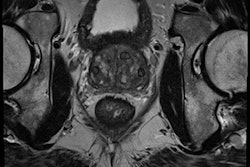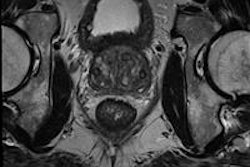
VIENNA - MR-guided biopsy (MRGB) of the prostate should only be performed in select patients, and it's vital to keep aware of false-negative results. Also, an urgent need exists for robust multicenter trials of targeted biopsies of the prostate, ECR delegates learned during a Special Focus session on Saturday.
On the plus side, an MR-guided biopsy is more efficient than a systematic transrectal ultrasound (TRUS) biopsy, the detection rate in TRUS-negative patients is between 40% and 50%, an MRGB yields longer core cancer length than a TRUS biopsy, an MRGB detects more significant and fewer insignificant cancers, fewer cores per patient are necessary, and an MRGB performs better than a cognitive biopsy, according to Dr. Bernd Hamm, director of the Institute of Radiology at the Charité in Berlin.
Conversely, an MRGB is time-consuming and expensive. Moreover, only limited data exist, and there is little or no evidence in favor of MRGBs, he explained. Whereas studies on MRGBs typically have been single-center trials involving between 10 and 100 patients, those on TRUS have been multicenter studies involving 1,000 or more patients.
"Most of the studies have a poor adherence to standards in reporting diagnostic accuracy. This is a concern, giving rise to the question: How good are we?" noted Hamm, who will be president of ECR 2015.
Overall, multiparametric MRI enables detection of significant cancers and is an accepted tool, especially in patients with a negative TRUS biopsy. An MRGB has high cancer detection rates, independent from numbers of previous TRUS biopsies.
Importantly, there is also a trend in the literature and in daily routine away from in-bore MR-guided procedures and toward MR/ultrasound fusion biopsies.
Strategies to improve TRUS biopsies include obtaining more biopsy cores, tackling the increased risk of infectious complications with every additional biopsy, and increasing the biopsy cutting length, depth, and number of cores.
From a urologist's perspective, the prime goal is adequate detection of significant cancers, which is why MRI and multiparametric MRI is so important, according to Dr. Bob Djavan, PhD, the director of the urology department of at the Veterans Affairs Hospital at New York University in the U.S. and a professor of urology at the Medical University of Vienna in Austria, where he also did his medical training. Another huge challenge is the accuracy of negative sampling, and imaging has a role here too.
"We have a problem identifying insignificant cancers," he said. "Today, active surveillance is a very popular tool in urology. We don't operate on every cancer today, and many patients go on to active surveillance, which means we don't treat them, we wait and we do biopsies and PSA [prostate-specific antigen testing]. If the PSA rises, then we operate."
Urologists need the imaging information that can help to reduce unnecessary biopsies, increase the detection rate, and predict the Gleason grade and cancer volume. The fusion of a TRUS and a multiparametric MRI is essential for this purpose, he said.
"Fusion means not only fusion of technologies but fusion of two specialties: urology and radiology. We need to work together," Djavan urged. "Biopsies should be a two-departmental matter in which imaging and urology work together."
It's not time to trash biopsies, but it's time to change how biopsies are performed, he continued. "Just doing more biopsy and lateral is not the solution. We need to add imaging information, specifically multiparametric MRI, and we need to learn how to do a good fusion."
Suitable fusion technology is not yet available, according to Djavan. It is not helpful to be able to have great parametric MRI exams that look wonderful in a lecture but do not help clinically when no fusion exists.
"The future will not be radical prostatectomy -- it pays my personal bills, and I'm very happy about that, but the future will be about not doing surgery in so many patients," he said. "I always say to urologists: A fool with a tool is still a fool. I'm very self-critical. If you give me an MRI, I'm still an idiot!"
There is a great need to rationally approach prostate cancer with new tools, according to session moderator Dr. Joan Vilanova, from Clínica Girona, Hospital Santa Caterina, University of Girona in Spain. Imaging must come first, with biopsy last, and MRI should play an important role in improving prostate cancer detection, said Vilanova, who strongly urged all ECR attendees to attend the 4th European Society of Urogenital Radiology Teaching Course on prostate MRI, which begins in Girona on 6 June 2014.
"I cannot promise you a table at El Celler de Can Roca, recently voted the best restaurant in the world, but I can promise you two excellent days of learning about prostate MRI," said Vilanova, who is the course director for the event.
Originally published in ECR Today on 9 March 2014.
Copyright © 2014 European Society of Radiology



















